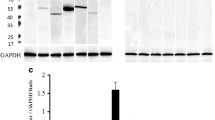Abstract
Pituitary adenylate cyclase activating peptide (PACAP) is a novel peptide isolated from the ovine hypothalamus. PACAP exists in 2 molecular forms with 27 (PACAP27) or 38 (PACAP38) amino acid residues. PACAP localization was studied by immunohistochemical methods in central (bone marrow and thymus) and peripheral (spleen, lymph nodes and duodenal mucosa) lymphoid tissues with antisera raised against PACAP27 or PACAP38. PACAP-positive cells were found in all lymphoid tissues examined. These cells were highly positive for PACAP38 but were negative for PACAP27. Morphologically, they were small mononuclear cells with relatively scarce cytoplasm and lymphocyte-like features. PACAP38-positive cells were abundant in peripheral lymphoid tissues (i.e., mesenteric lymph nodes). In the duodenal mucosa, PACAP38-positive cells were located either in the lamina propria or epithelium. These results suggest that PACAP38-positive cells are present within lymphoid tissues and may represent a lymphocyte-like cell subpopulation that has a potential role in cell-to-cell interactions in the immune system and in the integrated communication between neuroendocrine and immune systems.
Similar content being viewed by others
References
Arimura A (1992) Pituitary adenylate cyclase activating polypeptide (PACAP): discovery and current status of research. Regul Pept 37:287–303
Arimura A, Somogyvari-Vigh A, Miyata A, Mizuno K, Coy DH, Kitada C (1991) Tissue distribution of PACAP as determined by RIA: highly abundant in the rat brain and testes. Endocrinology 129:2787–2789
Cardell LO, Uddman R, Luts A, Sundler F (1991) Pituitary adenylate cyclase activating peptide (PACAP) in guinea-pig lung: distribution and dilatory effects. Regul Pept 36:379–390
Enerback L (1986) Mast cell heterogeneity: the evolution of the concept of a specific mucosal mast cell. In: Befus AD, Bienenstock J, Denburg JA (eds) Mast cell differentiation and heterogeneity. Raven Press, New York, pp 1–26
Gaytan F, Bellido C, Carrera G, Aguilar E (1990) Differentiation of mast cells during postnatal development of neonatally estrogentreated rats. Cell Tissue Res 259:25–31
Harbour DV, Smith ED, Blalock JE (1987) A novel processing pathway for proopiomelanocortin in lymphocytes: endotoxin induction of a new prohormone processing enzyme. J Neurosci Res 18:95–101
Hsu SM, Raine L, Fanger H (1981) Use of avidin-biotin-peroxidase complex (ABC) in immunoperoxidase techniques. A comparison between ABC and unlabeled PAP procedures. J Histochem Cytochem 29:577–579
Koves K, Arimura A, Somogyvari-Vigh A, Vigh S, Miller J (1990) Immunohistochemical demonstration of a novel hypothalamic peptide, pituitary adenvlate cyclase activating polypeptide in the ovine hypothalamus. Endocrinology 127:264–271
Miyata A, Arimura A, Dahl RR, Minamino N, Uehara A, Jiang L, Culler MD, Coy DH (1989) Isolation of a novel 38 residue-hypothalamic polypeptide which stimulates adenylate cyclase in pituitary cells. Biochem Biophis Res Comm 164:567–574
Miyata A, Jiang L, Dahl RD, Kitada C, Kubo K, Fujino M, Minamino N Arimura A (1990) Isolation of a neuropeptide corresponding to the N-terminal 27 residues of the pituitary adenylate cyclase activating poly-peptide with 38 residues (PACAP38). Biochem Biophys Res Comm 170:643–648
Montgomery DW, LeFevre JA, Ulrich ED, Adamson CR, Zukoski C (1990) Identification of prolactin-like proteins synthesized by normal murine lymphocytes. Endocrinology 127:2601–2603
Ottaway CA (1984) In vitro alteration of receptors for vasoactive intestinal peptide changes the in vivo lacalization of mouse T cells. J Exp Med 160:1054–1069
Ottaway CA, Greenberg GR (1984) Interaction of vasoactive intestinal peptide with mouse lymphocytes: specific binding and the modulation of mitogen responses. J Immunol 132:417–423
Schrader JW, Scollay R, Battye F (1983) Intramucosal lymphocytes of the gut: Lyt-2 and Thy-1 phenotype of the granulated cells and evdience of the presence of both T cells and mast cell precursors. J Immunol 130:558–564
Shivers BD, Görcs TJ, Gottschall PE, Arimura A (1991) Two high affinity binding sites for pituitary adenylate cyclase-activating polypeptide have different tissue distributions. Endocrinology 128:3055–3065
Sundler F, Ekbland E, Absood A, Håkanson R, Koves K, Arimura A (1992) Pituitary adenylate cyclase activating peptide: a novel vasoactive-like neuropeptide in the gut. Neuroscience 46:439–454
Tatsuno I, Gottschall PE, Arimura A (1991) Inhibition of mitogen-stimulated proliferation of murine splenocytes by a novel neuropeptide, pituitary adenylate cyclase activating polypeptide: a comparative study with vasoactive intestinal peptide. Endocrinology 128:28–34
Uddman R, Luts A, Assod A, Arimura A, Ekelund M, Desai H, Håkanson R, Hambreaus G, Sundler F (1991) PACAP, a VIP-like peptide, in neuros of the esophagus. Regul Pept 36:415–422
Author information
Authors and Affiliations
Rights and permissions
About this article
Cite this article
Gaytan, F., Martinez-Fuentes, A.J., Garcia-Navarro, F. et al. Pituitary adenylate cyclase-activating peptide (PACAP) immunolocalization in lymphoid tissues of the rat. Cell Tissue Res 276, 223–227 (1994). https://doi.org/10.1007/BF00306107
Received:
Accepted:
Issue Date:
DOI: https://doi.org/10.1007/BF00306107




